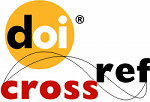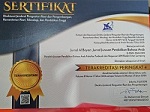National Arabic Test based on Higher Order Thinking Skills
Abstract
Keywords
Full Text:
PDFReferences
Al-Adawi, S, A.S.S. Dorvlo, D.T. Burke, S.Moosa, and S. Al-Bahlani “A Survey of Anorexia Nervosa Using the Arabic Version of the EAT-26 and ‘Gold Standard’ Interviews among Omani Adolescents.” Eating and Weight Disord 7, (2002): 304–311.
Alfahad, Abdulrahman. “Aggressiveness and Deference in Arabic Broadcast Interviews.” Journal of Pragmatics 88, (2015): 58–72.
Alhawarat, M, and Ahmad O Aseeri. “A Superior Arabic Text Categorization Deep Model (SATCDM).” IEEE Access 8, (2020): 24653–24661.
Alruily, Meshrif. “Classification of Arabic Tweets: A Review.” Electronics 10, no. 1143 (2021): 1-31.
Alzubaidi, Hamzah, Kevin Mc Namara, Colette Browning, and J Marriott. “Barriers and Enablers to Healthcare Access and Use among Arabic-Speaking and Caucasian English-Speaking Patients with Type 2 Diabetes Mellitus: A Qualitative Comparative Study.” BMJ Open 5 (2015): 1-11.
Amro, Iman et al. “Cross-Cultural Adaptation of the Arabic Positive and Negative Syndrome Scale in Schizophrenia: Qualitative Analysis of a Focus Group.” Transcultural Psychiatry 56, no. 5 (2019): 973-991.
Arifianto, Muhammad Lukman et al. Evaluasi Pembelajaran dan Pengembangan Tes Interaktif Bahasa Arab. (Yogyakarta: Tonggak Media, 2021).
Barlas, Asma. Believing Women in Islam: Unreading Patriarchal Interpretations of the Qur’an. (Austin : University of Texas Press, 2019).
Brandl, Klaus. “The Integration of Internet-Based Reading Materials into the Foreign Language Curriculum: From Teacher-to Student-Centered Approaches.” Language Learning & Technology 6, no. 3 (2002): 87–107.
Cheng, Betty H C, and Joanne M Atlee. “Research Directions in Requirements Engineering.” Future of Software Engineering, (2007): 285–303.
Fauziah, Indah Rahmi Nur, Syihabudin, and Asep Sopian. “Analisis Kualitas Tes Bahasa Arab Berbasis Higher Order Thinking Skill (HOTS).” Lisanuna 10, no. 1 (2020): 45–54.
Febriani, Suci Ramadhanti. “Implementation of Arabic Learning during COVID-19 Emergency in Indonesia: HOTS, MOTS, or LOTS?.” Alsinatuna:Journal of Arabic Linguistics and Education 5, no. 2 (2020): 117–129.
Georgas, James. “Family: Variations and Changes across Cultures.” Online Readings in Psychology and Culture 6, no. 3 (2003): 1-16.
Hamidah, Hasanatul. “Merancang Langkah-Langkah Stategis Pembelajaran Bahasa Arab Berorientasi Hots untuk Menyongsong Era Industri 4.0.” Multaqa Nasional Bahasa Arab 1, no. 1 (2018): 1–12.
Hidayatulloh, Hidayatulloh, Mochammad Shofwan, and Mardiyah, “Studi Komparasi KMA No. 183 Tahun 2019 dengan KMA No. 165 Tahun 2014 Tentang Pedoman Kurikulum 2013 Materi PAI dan Bahasa Arab.” Cendekia: Jurnal Ilmu Pengetahuan 2, no. 1 (2022): 16–24.
Hirschler, Konrad. Written Word in the Medieval Arabic Lands: A Social and Cultural History of Reading Practices. (Edinburgh : Edinburgh University Press, 2012).
Ismail, Moh, and Aufa Alfia Musthafa. “Pengembangan Materi Tes Keterampilan Menyimak Bahasa Arab Menggunakan Moodle untuk Meningkatkan Kemampuan Menyimak Mahasiswa Universitas Darussalam Gontor.” Jurnal At-Ta’dib 13, no. 2 (2018): 28-49.
Johnston, Nicole, Helen Partridge, and Hilary Hughes. “Understanding the Information Literacy Experiences of EFL (English as a Foreign Language) Students.” Reference Services Review, (2014): 1-259.
Kafi, Fina Aunul,and Zidni Ilma. “Analisis Soal Tematik Bahasa Arab berbasis HOTS pada Kelas XII MAN 3 Jember.” Al-Fusha: Arabic Language Education Journal 4, no. 1 (2022): 1–9.
Kamal, M. “Research and Development (R&D) Tadribat/Drill Madrasah Aliyah Class x Teaching Materials Arabic Language.” Santhet: Jurnal Sejarah, Pendidikan, dan Humaniora 4, no. 1 (2020): 10–18.
Kerssens‐van Drongelen, Inge C, and Andrew Cooke. “Design Principles for the Development of Measurement Systems for Research and Development Processes.” R&D Management 27, no.4 (1997): 345–357.
Mustain, Moch Ali. “Pembelajaran Bahasa Arab Berbasis Higher Order Thinking Skills (HOTS).” Seminar Nasional Bahasa Arab Mahasiswa, no. 3 (2019) : 386–398.
Ralph, Angelique F et al. “Attitudes and Beliefs about Deceased Organ Donation in the Arabic-Speaking Community in Australia: A Focus Group Study.” BMJ Open 6, (2016): 1-10.
Ramli, Saipolbarin, Muhammad Taufiq Abdul Ghani, Nazri Atoh, and Taj Rijal Muhamad Romli. “Integrasi Elemen Kemahiran Berfikir Aras Tinggi (KBAT) Berasaskan Kit Media dalam Amalan Pembelajaran dan Pemudahcaraan Guru Pelatih Bahasa Arab.” International Journal of Language Education and Applied Linguistics 9, no. 1 (2019): 33–44.
Raswan, Raswan. “Hisāb Ikhtibār al-Lughah al-‘Arabiyyah ‘Alā al-Mustawa al Wathany Li L-Madāris as-Tsānawiyyah al-Islāmiyyah Fī Indonesiā.” Jurnal Pendidikan Islam 3, no. 1 (2017) : 95–108.
Rodiaman, Idan. “Upaya Meningkatkan Minat Belajar Peserta Didik pada Pembelajaran Geografi Materi Dinamika Kependudukan dengan Penerapan Model Discovery Learning pada Kelas XI IPS di SMA Negeri 1 Denpasar/Efforts to Increase Students’ Interest in Learning Geography of Population Dynamics Materials with The Application of The Discovery Learning Model in Class Xi IPS at SMA Negeri 1 Denpasar.” Jurnal Geographia 2, no. 1 (2021) : 30–33.
Rosyidi, Abdul Wahab, and Mamlu’atul Ni’mah. Memahami Konsep Dasar Pembelajaran Bahasa Arab. (Malang: UIN-Maliki Press, 2011).
Rukmantara, Rachel Aziza, and Septi Gumiandari. “Penggunaan Audio Visual Youtube ‘Arabic Podcast’ pada Pembelajaran Maharah Kalam di SMA Muhammadiyah 4 Depok.” Jurnal Pendidikan dan Konseling 4, no. 5 (2022): 2459–2466.
Salam, Muhammad Yusuf, and Adam Mudinillah. “Canva Appliscation Development for Distance Learning on Arabic Language Learning in MTs Thawalib Tanjung Limau Tanah Datar.” Jurnal Teknologi Pendidikan 23, no. 2 (2021): 101–111.
Khaled and Mostafa Al-Emran, and Khaled Shaalan. “A Survey of Arabic Text Mining.” In Intelligent Natural Language Processing: Trends and Applications 740, 417–431.
Santoso, Ari et al. Jendela Pendidikan dan Kebudayaan. (Jakarta: Kementrian Pendidikan dan Kebudayaan RI, 2018).
Shatnawi, Mohammed Q, Muneer Bani Yassein, and Reem Mahafza. “A Framework for Retrieving Arabic Documents based on Queries Written in Arabic Slang Language.” Journal of Information Science 38, no. 4 (2012): 350–365.
Simamora, Roy Martin, Daniel de Fretes, Ezra Deardo Purba, and Daniel Pasaribu. “Practices, Challenges, and Prospects of Online Learning during Covid-19 Pandemic in Higher Education: Lecturer Perspectives.” Studies in Learning and Teaching 1, no. 3 (2020): 185–208.
Sofyan, Fuaddilah Ali. “Implementasi HOTS pada Kurikulum 2013." Jurnal Inventa 3, no. 1 (2019): 1-17.
Syamaun, Nurmasyithah. “Pembelajaran Maharah al-Kalam untuk Meningkatan Keterampilan Berbicara Mahasiswa Program Studi Pendidikan Bahasa Arab Fakultas Tarbiyah dan Keguruan.” لسـانـنـا (LISANUNA): Jurnal Ilmu Bahasa Arab dan Pembelajarannya 4, no. 2 (2016): 343–359.
Tapper, Richard. “Islamic Anthropology and the Anthropology of Islam.” Anthropological Quarterly 68, no. 3 (1995): 185–193.
Wahed, Abd. “Strategi Mewujudkan Sekolah dan Madrasah Unggulan di Era Global.” Al-Ibrah 3, no. 1 (2018): 1–28.
Wångdahl, Josefin, Ragnar Westerling, Per Lytsy, and Lena Mårtensson. “Perspectives on Health Examination for Asylum Seekers in Relation to Health Literacy–Focus Group Discussions with Arabic and Somali Speaking Participants.” BMC Health Services Research 19, no. 676 (2019): 1–12.
Wardhana, Dharendra. “Kajian Kebijakan dan Arah Riset Pasca-Covid-19.” The Indonesian Journal of Development Planning 4, no. 2 (2020): 223–239.
Woods, William A. “Progress in Natural Language Understanding: An Application to Lunar Geology.” In Proceeding National Computer Conference, (1973): 441–450.
Wulandari, Septiya, Hajidin, and M Duskri. “Pengembangan Soal Higher Order Thinking Skills (HOTS) pada Materi Aljabar di Sekolah Menengah Pertama.” Jurnal Didaktik Matematika 7, no. 1 (2020): 200–220.
Zubaidi, Ahmad. “Development of Mahârah al-Istimâ’ Test Instrument for Electronic based Arabic Student Using the Kahoot! Application.” Arabiyat: Jurnal Pendidikan Bahasa Arab dan Kebahasaaraban 7, no. 1 (2020): 61-77.
DOI: http://dx.doi.org/10.24042/albayan.v14i2.13713
Refbacks
- There are currently no refbacks.
Copyright (c) 2022 Jurnal Al Bayan: Jurnal Jurusan Pendidikan Bahasa Arab
License URL: https://creativecommons.org/licenses/by-nc-sa/4.0
Editorial Office:
Jurnal Al Bayan: Jurnal Jurusan Pendidikan Bahasa Arab, Arabic Education Study Program, Faculty of Education and Teachers Training, Unversitas Islam Negeri Raden Intan Lampung
Jl. Endro Suratmin 1 Sukarame, Bandar Lampung 35131-Indonesia
e-mail: jurnalalbayan@radenintan.ac.id
http://ejournal.radenintan.ac.id/index.php/albayan/index
Jurnal Al Bayan: Jurnal Jurusan Pendidikan Bahasa Arab is licensed under a Creative Commons Attribution-ShareAlike 4.0 International License. p-ISSN 2086-9282 | e-ISSN 2549-1229









